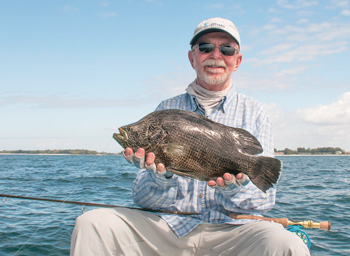Tripletail – a unique species

rusty chinnis | submitted
Rusty Chinnis caught this tripletail on fly while fishing
a marker off Longboat Key.
Tripletail are a unique species of fish that make a strong appearance in local waters after traps are placed in the Gulf during stone crab season. Tripletail like all kinds of structure – floating debris, channel markers, and swim buoys, but most anglers target crab trap floats this time of the year because they are so prevalent.
This curious fish has the general shape of a fresh water crappie and the coloration of a smallmouth bass. The name tripletail comes from their large anal and dorsal fins.
They are most often found floating on their side very close to a float or other structure. Tripletail are ambush feeders and prey on the small baitfish and crustaceans that are attracted to the algae that grows on the structure they gravitate to.
Most anglers look for tripletail while fishing for other species, keeping an eye out for them near crab trap floats in the Gulf. The best tactic once a fish has been spotted is to make a wide circle back to the marker, giving the fish time to settle down. A trolling motor is helpful to make an approach, but isn’t critical. A drift past the marker at a comfortable casting distance works just fine, but make sure you avoid drifting into the marker.
The weaker tides seem to be better for working crab trap lines, but I’ve seem tripletail on floats in a strong moving tide. Wind in and of itself doesn’t seem to bother tripletail as much as it complicates the approach and your presentation.
It’s best to work the trap or structure from the downwind side to avoid blowing into the fishes’ comfort zone. It’s harder to cast into the wind, but this tactic is usually much more effective.
Tripletail are one of the only species that will respond to a fly or lure fished in their direction. In fact that’s the most productive tactic. Since they are usually tight to structure, it’s important to use a lure or fly with a weed guard to prevent a hook up on the structure.
Tripletail rely on deception, mimicking a piece of moss that you’ll often find hanging from crab trap lines. Look for tripletail with its nose right on the structure and notice how its body shape and color closely matches the mosses. If you miss a strike, try again because tripletail are not shy about hitting a fly or lure multiple times. It’s also possible to return to a trap after a foiled hook up and fool them a second time.
While most of the tripletail run from four to 10 pounds, it’s possible to hook fish 15 pounds or larger. Since you’re looking for them around structure, you may need to apply a bit of muscle to separate them from their haunts. A fast nine-weight fly rod or a 10-pound spinning outfit will usually suffice for fish you’ll find in the Gulf, but downsizing to an eight-weight fly rod or eight-pound spinning tackle will make the hunt more sporting and fun.
Flies or lures for tripletail should resemble a baitfish, crab or shrimp, track well, and look alive. Clouser minnows and bend back flies are good choices. A DOA shrimp fly can fool even the most stubborn tripletail. Weed guards are a good idea when possible so you can cast right on top of the markers and trap lines where the fish hang out. Lures like the DOA Shrimp and jigs are also very effective.
When the season ends May th and the traps are pulled, many anglers stop looking for tripletail, but this actually concentrates fish around the remaining crab traps, buoys, markers in the bay and abandoned ghost traps.
Tripletail can be a challenging fish, sometimes easy to find and often hard to locate. The best action seems to be off the beach in 30 plus feet of water, but tripletail will venture closer inshore and are even found in the bay. The next time you’re out, keep an eye out for this unusual and feisty gamefish.

